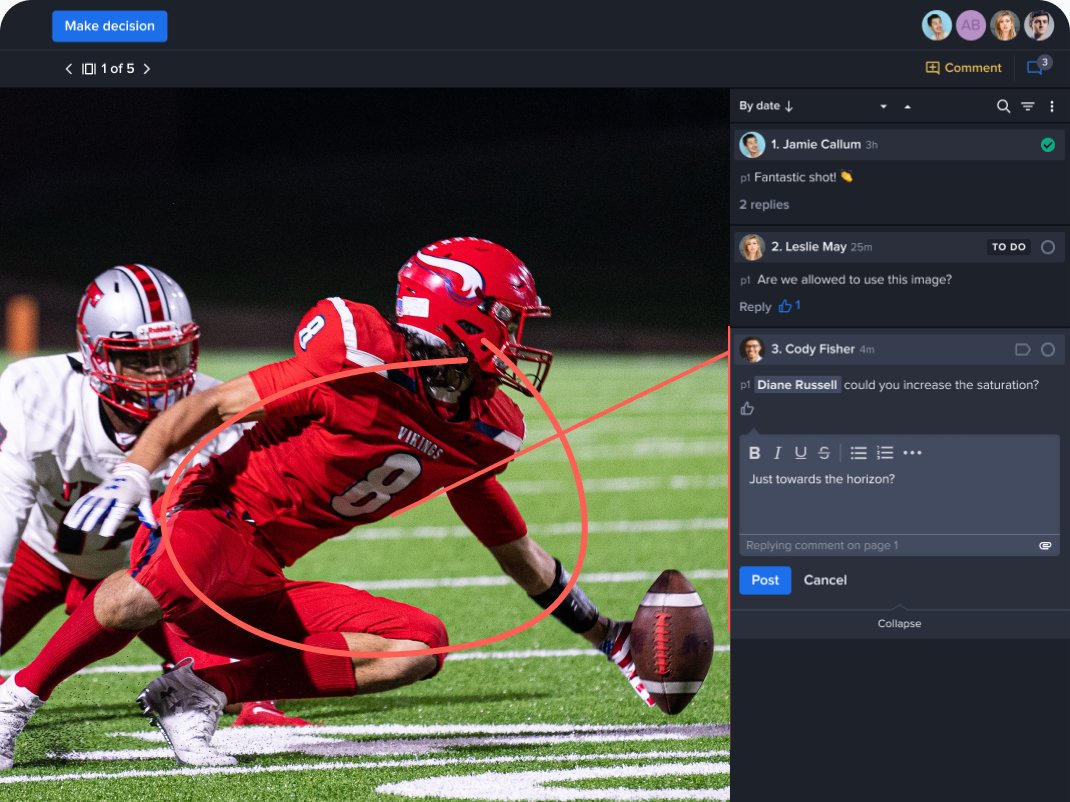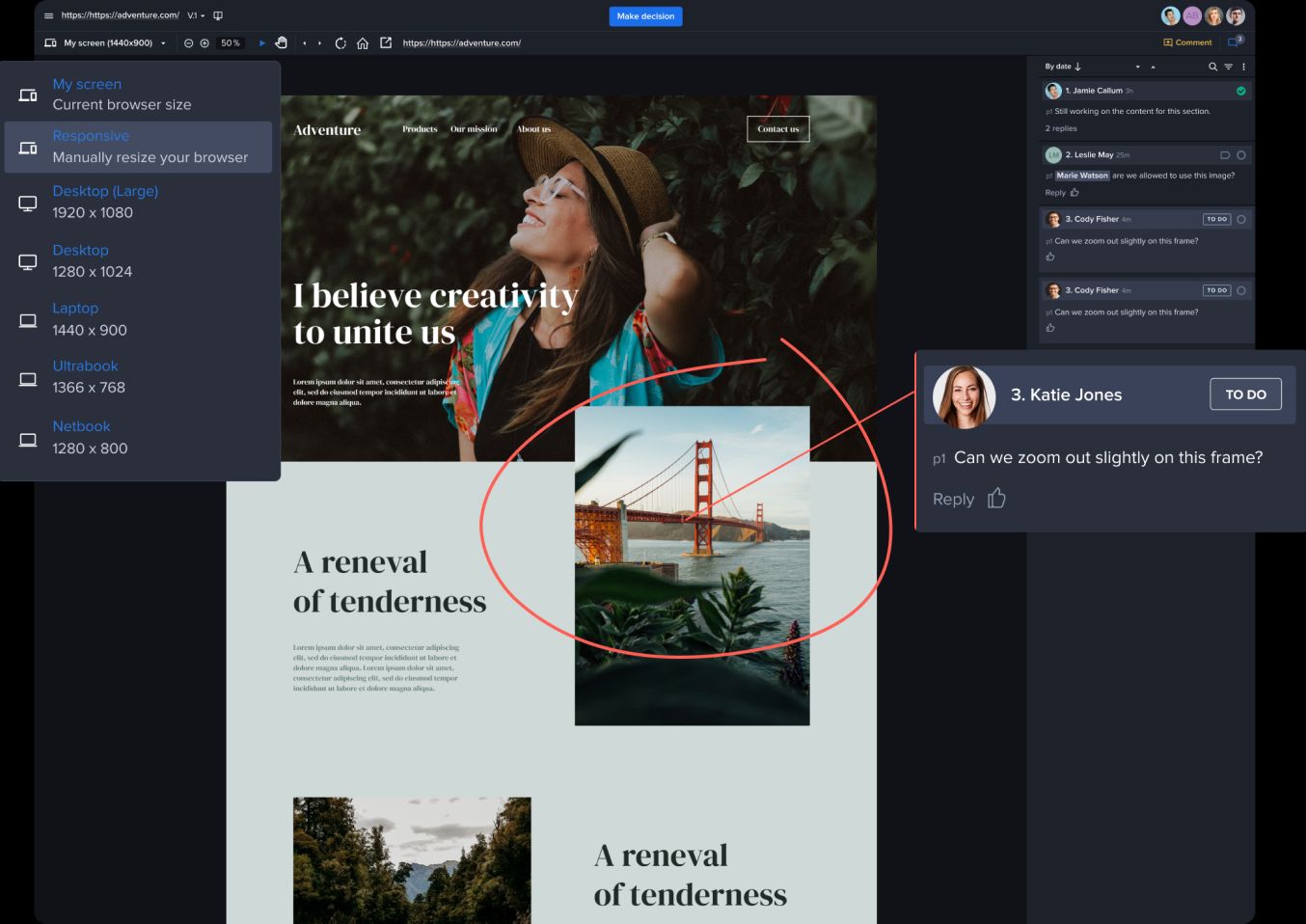“Can we make it pop more?”
At some point, every creative person has encountered this dreaded phrase.
Designers, creative directors, or marketing managers have all had the experience of sending great work around for review, only to be met with vague statements or confusing comments.
Or, a simple revision request may spark a major discussion that leads to more changes–and suddenly the entire direction of a creative project has done a complete about-face. Add in several conflicting opinions, and the process of giving and receiving creative feedback can quickly extend the intended timeline of a new project.
In the quest to get good creative feedback, creatives just know something might not go smoothly once their work is up for review.
Whether you’re collaborating internally or you’re working with external clients or stakeholders who weigh in on visual and creative work, giving effective, good feedback doesn’t have to be a struggle. Read on for four must-have tips for streamlining the feedback process for creative work.
Combat personal tastes by consulting the project brief and brand guidelines
We all have a gut reaction to visual work. When viewing work for the first time or reviewing revisions, it can be easy to let personal tastes override brand standards.
Before providing detailed feedback–whether it's version one or version twenty–creative work should be viewed through the lens of the overall project objectives and visual guidelines. Consulting the project brief can help you remove your biases when evaluating visual work and view work through the lens of the project objectives.
Brand briefs and brand standards set an agreed-upon foundation for visual direction and project intention. This creates parameters for both the production of the creative work and feedback on that work and saves your creative team from having to explain why certain design or copy choices were made.

It’s one of the many reasons that having a creative brief and brand guidelines in place are so important.
Before leaving a comment, consider if the change requested will service the project goals and or brand guidelines. Often, reviewing brand standards can lead to improvements that maintain brand integrity. However, feedback can often stray too far from these guidelines, take conversations off course, and waste valuable time for both reviewers and creatives. Consulting the details of a creative brief can help keep all feedback on the same railroad tracks.
Add as much context as possible to creative feedback
Creatives love feedback that is actionable or collaborative. One major roadblock to the feedback process is vague or unactionable comments such as:
“I love the design!”
“I don’t like this, can we try something else”
“This is good, but…”
When leaving feedback, being as clear and direct as possible helps speed up the iteration process. Even positive feedback should have some context about why creative work met the mark.
Markups, timestamps, auto-compare, text replacements and other design feedback tools can all help contextualize and clarify which elements of creative work require revision. Without detailed annotation options, creatives may be left guessing specifically what needs to change and spend additional time on unnecessary or incorrect revisions.

However, perhaps a comment sparks a larger discussion around the direction of a design element –that’s perfectly ok! It’s part of the creative collaboration process. These conversations should happen directly on the asset itself as to avoid straying too far into scope creep territory. All feedback should have a point of reference directly on the creative work so it’s always clear what element is up for discussion.
Have (and know) the hard deadlines for revisions
When giving feedback, knowing the level of effort required to make a change can help you determine how critical the change actually is. Swapping out an image? Perhaps that will take a designer a few minutes of time and can be accomplished quickly. Changing the entire color palette across all campaign assets? That may require a full day’s work for your creative team.
It’s important to weigh the effort of change against the purpose of the change. Creative teams should always strive for excellence, but endless revisions can turn something that is perfectly workable for an intended project goal into a major time drain. At some point, revisions need to reach a stopping point so new work can begin.

One way to “close” the feedback process is with decision checklists with detailed reasons that indicate why assets have been approved or not. This essentially puts an end to the feedback process and a clear marker of when work is considered complete.
Don’t email your creative feedback
The method by which you deliver feedback is just as important as the feedback itself.
Even for creative teams working on complex campaigns or many different types of assets, emailing work around for input and communicating changes via long email threads remains the status quo.
However, a lot can get lost in translation with email.
Improving the clarity of feedback on creative and design work can come simply from moving your feedback process into a singular review environment with dynamic on-asset markups.
This takes a ton of guesswork out of the feedback process, as detailed visual feedback can be applied directly and specifically to creative assets that are visible to everyone, across every version.

If you’re looking for a silver bullet for drastically improving how feedback is given and received, moving the feedback process out of email as much as possible into a review environment brings immediate dividends across the team.
Give (and gather) good creative feedback, not chaos
Providing good creative feedback requires a mix of clear communication and efficient methods for leaving comments and collaborating on creative work.
Removing personal biases, knowing brand standards, moving away from email, collaborating with clarity, and respecting feedback deadlines all help the creative process move more quickly and smoothly with your creative and design team. The creative feedback process doesn't have to be chaotic. These tried-and-true methods will have your creative team in high spirits and eager to work together on the next project.




